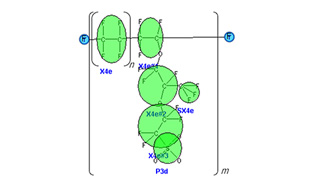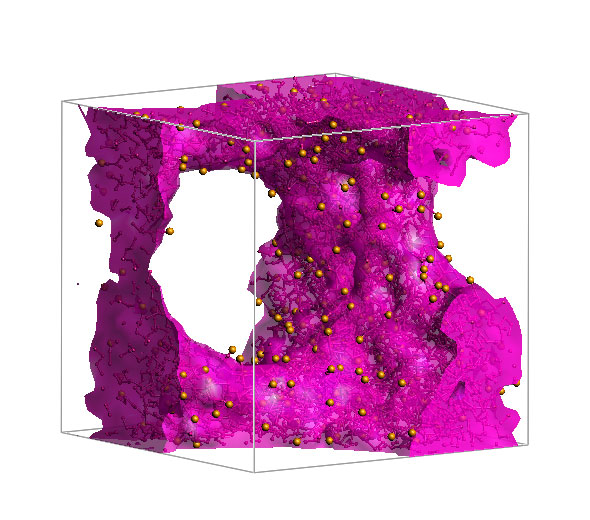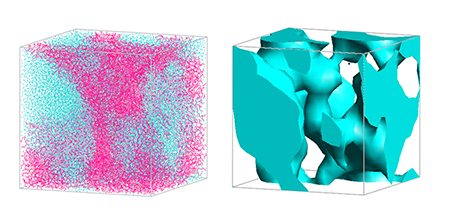Simulation of Nafion membrane using Marini3 force field
- Modeling using a general-purpose Coarse-Grained Force Field
- Analysis focusing on chemical functional groups
- Easy analysis even for large-scale models
Modeling using a general-purpose Coarse-Grained force field
A Coarse-Grained model of a Nafion molecule created using the Martini3 force field is shown. Each Coarse-Grained particle represents multiple atoms, significantly improving computational efficiency. This enables structural analysis at the nanoscale within realistic computational time.

Analysis focusing on chemical functional groups
The relaxed structure of a system containing 20 Nafion molecules and 5000 water particles is shown. The isosurface of the Nafion main chain at a volume fraction of 0.5 and the distribution of sulfonic acid groups are visualized. The sulfonic acid groups are represented as yellow spheres and are mostly located in the interfacial region with water. This distribution indicates a key structural feature for the Nafion membrane to function as an ion-exchange membrane and suggests its contribution to proton conductivity through interaction with water.

Easy analysis even for large-scale models
A water channel structure obtained from a large-scale model containing a Nafion 160 molecule and 24,000 water particles is shown. The cell edge length is 18 nm, and the isosurface at a water volume fraction of 0.5 is displayed. From this figure, the complex water network structure formed within the membrane can be visually confirmed, providing useful information for understanding water transport pathways and membrane permeability.

[2] Batatia, I., Kovacs, D. P., Simm, G. N. C., Ortner, C., & Csanyi, G. (2022, October 31). MACE: Higher order equivariant message passing neural networks for fast and accurate force fields. OpenReview.
[3] Bartók, A. P., Payne, M. C., Kondor, R., & Csányi, G. (2010). Gaussian Approximation Potentials: The Accuracy of Quantum Mechanics, without the Electrons. Physical Review Letters, 104(13).
[4] Kulda, J., Strauch, D., Pavone, P., & Ishii, Y. (1994). Inelastic-neutron-scattering study of phonon eigenvectors and frequencies in Si. Physical Review. B, Condensed Matter, 50(18), 13347-13354.
[5] Inyushkin, A. V., Taldenkov, A. N., Gibin, A. M., Gusev, A. V., & Pohl, H. (2004). On the isotope effect in thermal conductivity of silicon. Physica Status Solidi. C, Conferences and Critical Reviews/Physica Status Solidi. C, Current Topics in Solid State Physics, 1(11), 2995-2998.AA5





